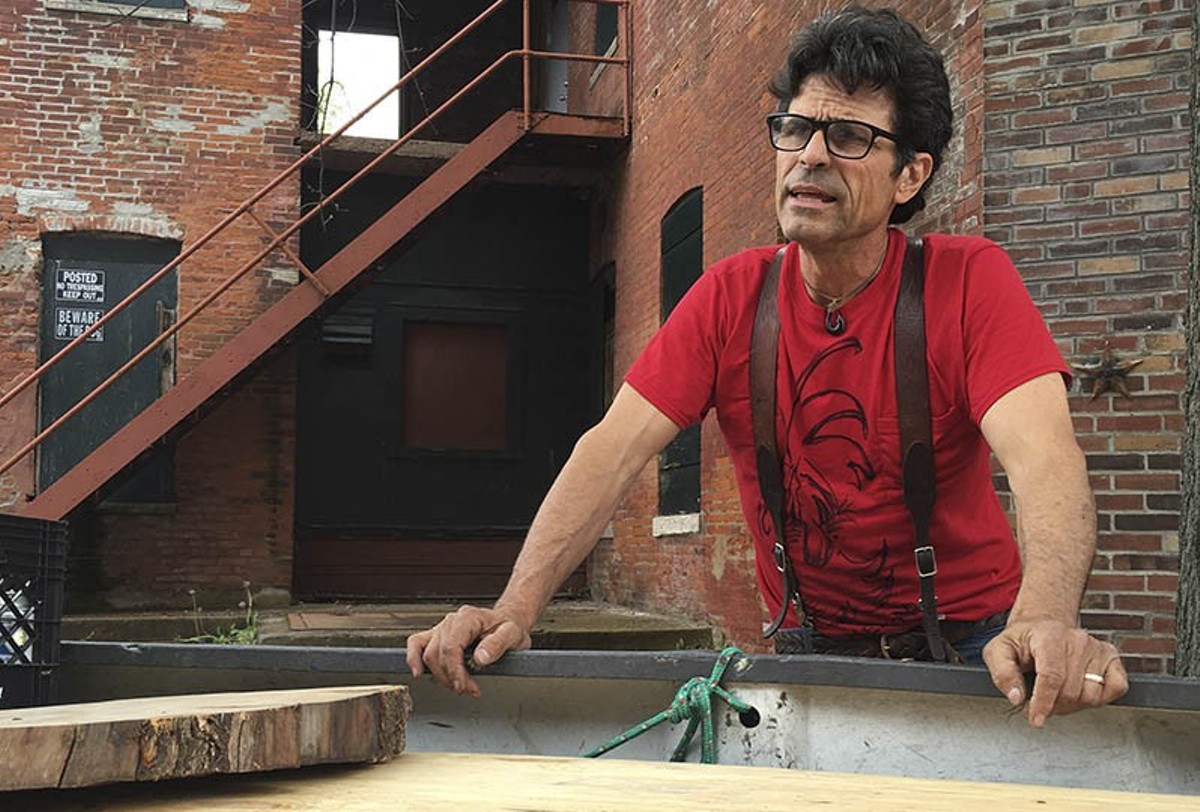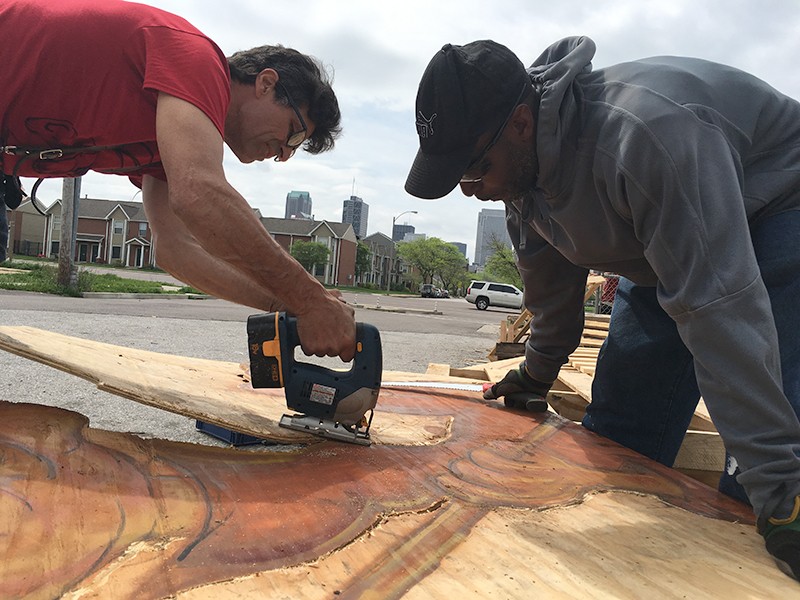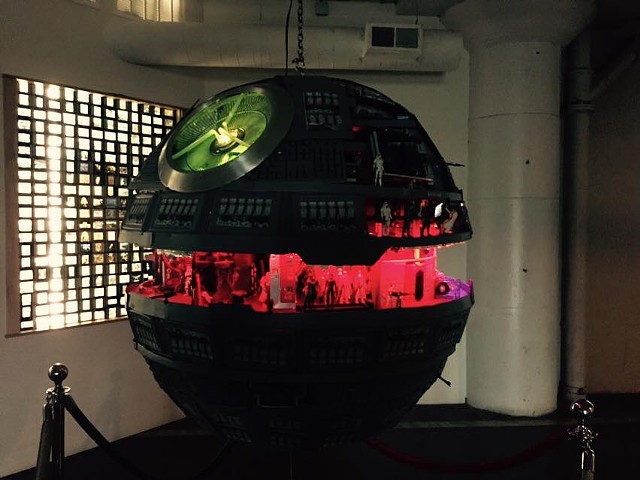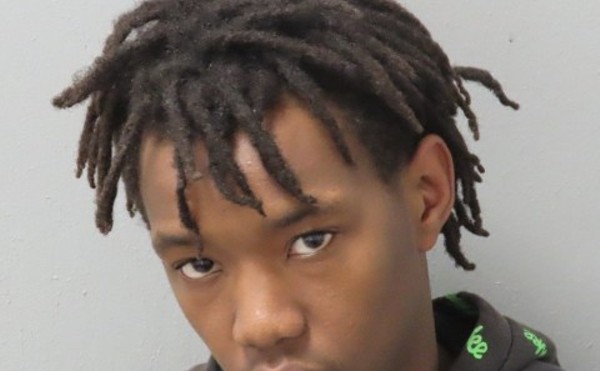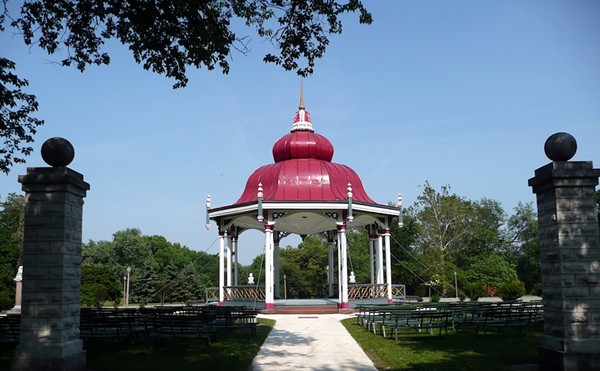For years, there was something of an unwritten code on where graffiti, and other forms of underground street art, like wheat-paste posters, stickers and stencils, might appear. Occupied buildings were generally off-limits. Ditto certain types of buildings, including churches and schools. Hitting brick was frowned on, as removal efforts can damage tuckpointing.
These days, those notions seem hopelessly outdated. Neighborhoods in which graffiti writers live and play — like Cherokee Street and South Grand — have taken some particularly hard hits, and the city's classic red bricks have not been spared. Industrial areas, such as the factory-and-warehouse districts south of downtown, are magnets, as are zones along major thoroughfares; a drive down I-70 from downtown to Berwick's Ferguson, for example, offers an ever-changing, illegal gallery of today's active graf writers.
Among the businesses that call for graffiti removal, says Brightside's Green, many are repeat customers. She notes her nonprofit's popular mandate, with money "raised through private funds, tax-deductible donations. Individuals support us, large and small, as well as foundations," she says. "Really, it comes down to the fact that the vandals are showing a great deal of disrespect for our community. The people who want to support Brightside want to make it a better place."
In essence, how badly a city or region is touched by graffiti owes to the relative ethics of those doing the painting. Berwick, not surprisingly, has his personal code, even though it differs from many other artists.
"Once a building's roof has gone," he says, "the building's gone." To him, that means it's "open season" for painters to move in and add blasts of color and messaging.
And the city of St. Louis is still a place of plentiful broken building stock. While many, if not most, would look at cracked, crumbling brick buildings as hopeless, Berwick sees at least a chance at redemption.
"There's power in words," he says, closing his eyes. "There's power in art."
He pauses, as he'll sometimes do when reaching for an idea. He can envision a city in which graf writers are given amnesty, solely on the condition that they work out in the open, on plywood attached to burn-outs and any other building with a half-decade of abandonment.
Discussing it, he recollects his time with the Paint for Peace effort. He wants to see if the legion of current graf writers have more in their creative quiver than an ability to quickly write their handles.
Just last week, he petitioned St. Louis Comptroller Darlene Green for this type of permission.
"We have an opportunity in St Louis to create an atmosphere of hope, peace, respect, and unity through live demonstrations of the arts," he wrote. "To have an impact, this will have to be done outside artist's studios, and in various selected places in the city where thousands walk past and drive past every day."
Berwick is no hypocrite, refusing to play where he sleeps. Three Merferds also dangle from the trees in front of his home. (Not surprisingly, he's already added his own, non-commissioned piece to the collection at the sculpture park across the street, including a book that dog-walkers can sign, housed in a lockbox, atop a tree trunk.) Two massive paintings of murdered St. Louisans sit propped up against his garage door, striking portraits of the deceased painted upon his preferred medium of plywood.
By enabling these types of projects and bringing street art out into the open, Berwick believes that graf writers, who often stick and move with fast, sloppy messages, will rise to the occasion and up their work. He really believes this.
"The taggers are armed and ready to paint," Berwick says. "That is, armed with paint. This is why I'd love to see the city, rather than looking at them as antagonists and enemies, let them come into the Paint for Peace community. We want to get the city on board. Everyone who's proud of their name and shows some real talent should paint some themes, love and forgiveness. Do it during the day, so we can watch you. I want to stress that if it's a functional, livable building, then you have no business on it. But if it's a goner, let's have painters add sensitive stuff: flowers, nature, names.
"You have these taggers coming out at night," he surmises. "They're doing what they're doing at night, so they don't get caught. I look at some of the art. It's on buildings that are irreparable. The heights, man; I have admired some of the heights they're working. I'm intrigued. They don't have a bucket truck! How are they doing that? I'd love for us all to be able to view that during the day. It'd be exciting, as exciting as watching someone climb a mountain."
On this point, Harrington, the Paint Louis organizer, agrees.
"Whether [Cox] is Super or not, the city needs a scapegoat," Harrington says in an email. "Instead of reaching out to artists and doing city beautification projects by letting the artists paint community-based murals on all the abandoned buildings in the city, they vilify and write them off as criminals. Most of the artists just want notoriety, but most galleries don't look at what they do as art, and regular people can't read it or tell the difference between street/urban art or gang writing." Thanks to those conditions, the artists have no choice, he says, but to paint outside the lines.
But there are, of course, places where time is taken for large-scale works. Places where graffiti exists in an almost-curated state. Places that few see.

